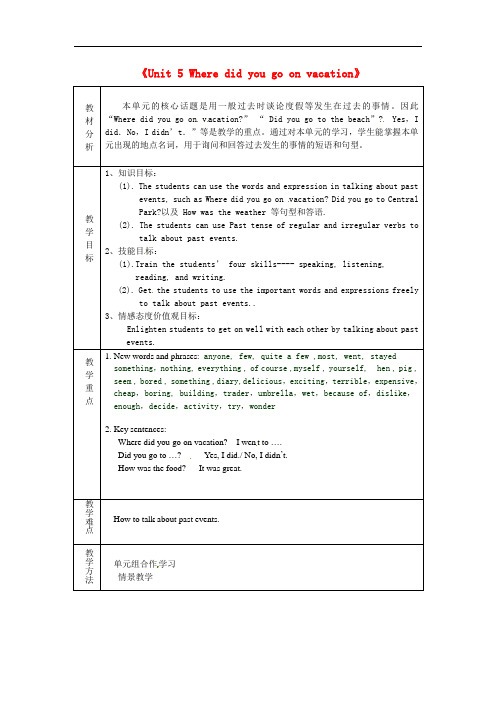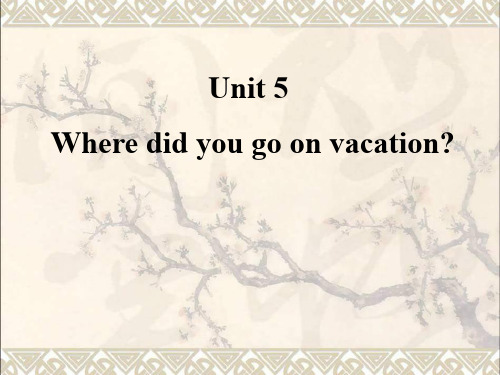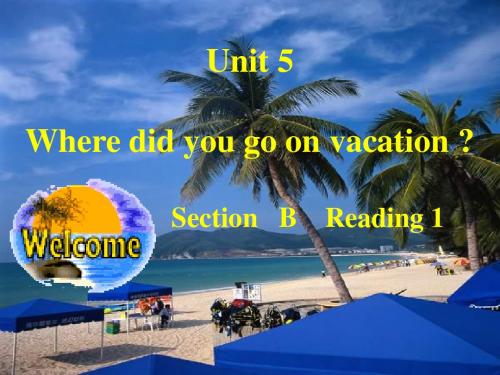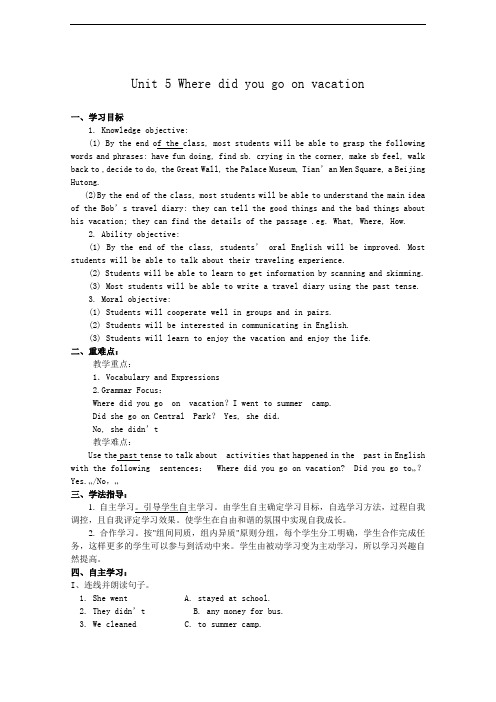2019年鲁教版英语七年级上册Unit 5 Where did you go on vacation?Section A(1a-1c)优质课课件
- 格式:ppt
- 大小:13.28 MB
- 文档页数:22

《Unit 5 Where did you go on vacation》
“Where did you go on v acation?” “ Did you go to the beach”? Yes
vacation?
、技能目标:
(1).Train the stud ents’ four skills
Get the
I wen
单元组合作学习
过去时,具有了学习本单元知识的认知前提,
教师要充分利用这一优势
Period One: S e
《Unit 4 what did you de last weekend Period 6》
to the report from the winners. Try to
Step Two: Lea rn by th emselves.
Ss: 1. De cide your own aims.
3. Group work: Talk about your problems in groups T: Instructions from the teach er if necessary
冠词。
这类句子的结构形式是:
:
ix: Show students how to preview for next class.
Choose your tasks :
附:一.课前检测题:个性预习作业同层对比
二.课堂检测题:对照所选目标进行同层对比
三、作业设置:
必做:预习Unit 5 P 33; 完成配套剩下的题目选做:同步训练阅读练习。

Unit 5 Where did you go on vacation?Section A(1a-2d)I.Teaching Aims:1) 能掌握以下单词:anyone, anywhere, wonderful, quite a few, most, something, nothing, everyone, of course, myself, yourself句型:① —Where did you go on vacation? —I went to the mountains.② —Where did Tina to on vacation? —She went to the beach.③ —Did you go with anyone? —Yes, I did./No, I didn’t.2) 能了解以下语法:—复合不定代词someone, anyone, something, anything等的用法。
—yourself, myself等反身代词的用法。
3)一般过去时态的特殊疑问句,一般疑问句及其肯定、否定回答。
Ⅱ. Teaching Main Points:1) 用所学的功能语言交流假期去了什么地方旅行。
2) 掌握本课时出现的新词汇。
III. Teaching Difficult Points:1) 复合不定代词someone, anyone, something, anything等的用法。
2) yourself, myself等反身代词的用法。
IV. Teaching Methods:Listening,speaking,practicingV. Teaching Procedures:1. Lead-inWelcome back to our school! I’m your English teacher this term. Can you tell me what you did in summer holiday?Where did you go? Who did you go with? What was the weather? Then ask several students to answer the questions.2. Presentation1). Show some pictures on the big screen. Let Ss read the expressions.2). Focus attention on the picture.Ask: What can you see? Say: Each picture shows something a person did in the past.Name each activity and ask students to repeat:Stayed at home, Went to mountains, went to New York City , Went to the beach, visited my uncle, visited museums, went to summer camp3). Now, please match each phrase with one of the pictures next to the name of the activity,point to the sample answer.4). Check the answers. Answers: 1. f 2. b 3. g 4. e 5. c 6. a 7. d3. Listening1. Point to the picture on the screen.Say: Look at the picture A. Where did Tina go on vacation? She went to mountains.Ask: What did the person do in each picture?2. Play the recording the first time.3. Play the recording a second time.Say: There are three conversations. The people talk about what did on vacation.Listen to the recording and write numbers of the names in the right boxes of the picture.4. Check the answers.4.Pair work1. Point out the sample conversation. Ask two Ss to read the conversation to the class.2. Now work with a partner. Make your own conversation about the people in the picture.3. Ss work in pairs. As they talk, move around the classroom and give any help they need.4. Let some pairs act out their conversations.5. Listening1). Tell Ss they will hear a conversation about three students’ conversations. Listen for the first time and fill in the chart. Then listen again and check Yes, or No.2). Let Ss read the phrases in the chart of 2b.3). Play the recording the first time. Ss listen and fill in the chart.4). Play the recording a second time for the Ss to check “Yes, I did.” or “No,I didn’t. ”5). Check the answers with the Ss.6. Pair work1. Let two Ss read the conversation between Grace, Kevin and Julie.2. Let Ss work in pairs and try to role-play the conversation.3. Ask some pairs to act out their conversations.7. Role-play1. First let Ss read the conversation and match the people and places they went.2. Let Ss act out the conversations in pairs.3. Some explanations in 2d.重点知识点:1.不定代词 anyone是不定代词,意为“任何人”,相当于anybody,主要用于疑问句或否定句中。

鲁教版英语七上Unit 5 Where did you go on vacation Section B 教学设计2一. 教材分析鲁教版英语七上Unit 5的主题是关于假期旅行的,Section B主要通过一个关于假期旅行的对话来帮助学生掌握一般过去时的表达方式。
本节课的主要内容是让学生能够运用一般过去时描述自己和他人的假期经历。
本节课的词汇和句子结构相对简单,适合学生进行口语练习和听力训练。
二. 学情分析学生在进入七年级时已经掌握了一定的英语基础,能够进行简单的英语交流。
但是,对于一般过去时的表达和运用还相对陌生。
因此,在教学过程中,需要引导学生理解和运用一般过去时。
此外,学生对于假期旅行的主题比较感兴趣,有利于激发他们的学习积极性。
三. 教学目标1.知识目标:学生能够掌握一般过去时的表达方式,并能够运用到实际情景中。
2.能力目标:学生能够听懂并能够运用一般过去时进行口头描述。
3.情感目标:通过本节课的学习,学生能够激发对英语学习的兴趣,增强学习的自信心。
四. 教学重难点1.重难点:一般过去时的表达方式。
2.原因:学生对于一般过去时的概念和用法比较陌生,需要通过大量的练习来掌握。
五. 教学方法1.交际法:通过模拟真实的假期旅行情景,让学生在实际交流中运用一般过去时。
2.任务型教学法:通过完成各种任务,如听力练习、小组讨论等,激发学生的学习兴趣和积极性。
3.视听法:利用多媒体教学资源,如图片、视频等,帮助学生更好地理解和记忆。
六. 教学准备1.教师准备:对于一般过去时的表达方式进行充分的了解和准备。
2.学生准备:学生需要预习本节课的内容,对于假期旅行的相关词汇进行学习。
七. 教学过程1.导入(5分钟)通过提问学生“你们最喜欢的假期活动是什么?”来引导学生思考和回忆假期的经历,激发学生的学习兴趣。
2.呈现(10分钟)教师通过展示一些关于假期旅行的图片,引导学生用英语进行描述。
同时,教师呈现一般过去时的表达方式,如“I went to…”、“I did…”等。



Unit 5 Where did you go on vacation一、学习目标1. Knowledge objective:(1) By the end of the class, most students will be able to grasp the following words and phrases: have fun doing, find sb. crying in the corner, make sb feel, walk back to ,decide to do, the Great Wall, the Palace Museum, Tian’an Men Square, a Beijing Hutong.(2)By the end of the class, most students will be able to understand the main idea of the Bob’s travel diary: they can tell the good things and t he bad things about his vacation; they can find the details of the passage .eg. What, Where, How.2. Ability objective:(1) By the end of the class, students’ oral English will be improved. Most students will be able to talk about their traveling experience.(2) Students will be able to learn to get information by scanning and skimming.(3) Most students will be able to write a travel diary using the past tense.3. Moral objective:(1) Students will cooperate well in groups and in pairs.(2) Students will be interested in communicating in English.(3) Students will learn to enjoy the vacation and enjoy the life.二、重难点:教学重点:1.Vocabulary and Expressions2.Grammar Focus:Where did you go on vacation?I went to summer camp.Did she go on Central Park? Yes, she did.No, she didn’t教学难点:Use the past tense to talk about activities that happened in the past in English with the following sentences: Where did you go on vacation? Did you go to…?Yes.…/No,…三、学法指导:1. 自主学习。
Unit5 SectionA〔Grammar focus-3c〕精品教案I.Teaching Aims:1) 复习所学的重难点句型及句式构造。
2〕总结学习anyone, someone, everyone, something, anything, nothing 等不定代词的用法。
3〕练习运用所学的句型及句式构造。
Ⅱ. Teaching Main Points:1) 用所学的功能语言交流假期去了什么旅行。
2) 复习运用本课时出现的新词汇。
III. Teaching Difficult Points:1) 复合不定代词someone, anyone, something, anything等的用法。
2) 阅读填空能力的提高。
IV. Teaching Methods:V. Teaching Procedures:1. Warming- up and revision1〕. Free talk: Ask Ss the questions: Where did you go on vacation? Ss try to answer the questions.2〕. Revi ew the usage of “复合不定代词〞2. Grammar focus.1〕. 学生阅读Grammar Focus中的句子,然后做填空练习。
1. 你去了什么地方去度假?______ ______ you go on ___________?2. 我去了纽约市。
I _______ _______ New York City.3. 你和什么人别一起去的吗?______ ______ go out with ________?4. 不,没有别人在这儿。
每个人都在度假。
No. ____ ______ was here.________ was on _________.2〕. 学生们完成填空试题后,可以翻开课本检查答案,对错误的句子,单独进展强化记忆。
Unit 5 Where did you go on vacation ?Section B评测练习本节课是一节以“度假”为话题的听说课,主要训练学生的听力和口语,所以设计的练习都是“度假”话题为主线贯穿始终的听说训练。
同时,将不定代词的语法教学分散融入到话题的各任务中。
利用生动有趣的各种游戏,来代替枯燥的语法演绎。
Exercise 1 : Listening practice : Lisa 的香港之旅Listen to the dialogue and match them (听力连线)What did Lisa say about…?her vacation excitingthe fun park expensivethe stores friendlythe people deliciousthe food. great精讲点拨:关于Lisa 的香港之行,用连线的形式让学生对听力内容有个大体的理解,练习听力技巧中抓关键词的能力。
设计意图: 现在大家都了解了我的香港之行,让我们听听力了解一下Lisa 的香港之行。
因为section B听力训练一开始的回答问题,填单词,对初二学生来说,有点难度,所以整合课本,换成了听力连线,听力填空,并把回答问题环节改成了对话的形式,这样更利于初二学生接受。
Exercise 2: Listen again and fill in the blanks. (听力填空)录音原文:Girl : Hi, Lisa. How was your vacation?Lisa : It was great! I went to __________ with my familyGirl : Really? Wow! Did you do __________ special there?Lisa : Well, we went to a fun _________. It was really exciting.Girl : Did you go shopping?Lisa : Yeah, I did .Girl : How were the stores?Lisa : Oh, They were very expensive. but I did buy __________ for my best friend.Girl : And how were the people? Were they friendly?Lisa : Yeah, they were really friendly. My parents have some friends there, and we had dinner at their house.Girl : How was the food?Lisa: It was _________. I love their home cooking!Girl: Did everyone have a good time?Lisa: Oh, yes, we did. ___________ was excellent.精讲点拨:通过完整的呈现录音原文,让学生边听边看,对整个听力内容有个比较全面的了解,有利于听力训练能力的提高。
Unit1 What does he look like?Section AStep1 Lead inUse a song The Family to lead in this lesson.Step2 Presentation1. Show the learning aims.Words:straight hair ,medium height, thin,hair, curly,straight, height, tall, thin,heavy,buildSentences:_what does she look like?_She has/is/is of…e some popular stars they know well to teach the words tall,short ,long ,medium height, medium build.Then practice “What does he look like?”in groups of three.Pay attention to “be”and “have/has”Next I will use some other pop stars to teach long hair ,short hair ,straight hair,curly hair.Pay attention to “have/has”Step3 Practice1. I’ll use some photos of the students in our class to let the students practice in pairs.2. 1a Use the letters to match the people in the picture with one ofthe numbered words. Write each letter next to a numbered word. Step4 Listening(Look at their books Listen and fill careful1y).Listen carefully and fill in the blanks and find Amy’s friend? We will listen twice.The first time, just listen.The second time,listen and fill in the blanks.And say Amy’s friend’s look.( He's really tall.And he has curly hair.)Step5 Practice1c 1.Ask two students to read the sample conversation to the class.2. Make a dialogue with a student. And ask the student to point out the person you described.Step6 Listening2a Listen and answer the questions. First look through the questions then listen and check the answers one by one.2b Listen again.Fill in the chart.Pay attention to the key words Then look at 2c ,ask and answer in pairsStep6 Reading2d Read the conversation and answer the questions.Then role play this dialogue.Step7 A guessing game1.Ask and guess who is my favorite classmate.2.猜图片全班同学分为几个小组,每组选出一名同学作为组代表到黑板前面来,这些同学面向其他同学,背向黑板,不许回头。
Unit 5 Where did you go on vacation? Section B教案ⅠTeaching modelListening and speakingⅡTeaching methodInteractive approachⅢTeaching aims1. To find specific information in the listening.2. To enable students to write a diary.3. To enable students to use different kinds of adjective.ⅣTeaching ObjectivesKey vocabulary: activity, decide, try, paragliding, bird, bicycle, building, trader, wonder, difference, top, wait, umbrella, wet, below, enough, hungry, as, hill, duck,dislike.Key phrases: feel like, because ofKey structures:1. —Where did…?2. —What did?3. —Did she?4. —How was...?5. How were…?ⅤTeaching aidsTape recorder, OHP, video \ⅥTeaching pointThe use of different kinds of adjectiveⅦTeaching StepsStep 1 Warming-up1. Lead inT: Hello, boys and girls!Ss: Hello, Mr. Zhang.T: Today, we are going to learn section B, But firstly, we’ll review section A . Have all of you finished homework?Ss: Yes!T: So which group will show us your conversation?S1: …S2: …T: Thank you, you have done good job. Since time is pressing, Shall we study section B now? Ss: Yes.T: Please look at the screen and get to know some information.Ss: … (Look at the screen and try to know some information about it.)2. Show some pictures to ask and answer: What can you see?3. Call back the answer from the whole class and check the answer.Step 2 Practice1. Introduce the new words.2. Look at the pictures. Ask and answer: What can you see?3. Call back the answers from the whole class and check the answer.4. Read the words.Step 3 Work in pairs1. Listen and check ( √) the words in Activity 1 you hear.2. Now work in pairs and say what you can see.Step 4 Listen and read.1. Ask the students to read the conversation silently.2. Play the recording and ask the students to listen and read the conversation.3. Read the conversation.4. Act it out.5. Ask the students to complete the table in Activity 3.6. Call back the answer from the whole class and check the answer.Step 5 Underline the correct words.1. Ask the students to read through the passage.2. Underline the correct words.3. Call back the answer from the whole class and check the answer.Step 6 Listen and repeat.1. Play the recording once without stopping.2. Play the recording again and stop at the end of each line. Ask the whole class to repeat.3. Play the recording again and stop at the end of each line. Ask individual students to repeat.4. Ask the students to practice the sounds in pairs.ⅧHomework1. Learn the new words by heart.2. Read and act out the dialogue.。